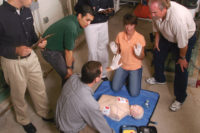This case is typical of the type of incident that can occur in confined spaces. Working in a confined space can be a challenging and dangerous job. Approximately 100 of such workers die on the job each year, says NIOSH. About half of the fatalities are workers attempting rescues. That’s why it is essential to learn and understand how to handle the specific hazards and conditions that your workers may encounter in a particular confined space.
Large enough, but…
Large enough and so configured that an employee can bodily enter and perform assigned work, a confined space has limited or restricted means for entry or exit, and it is not designed for continuous employee occupancy. Even if the size of the opening is large, open-topped pits or degreasers are confined spaces because they are difficult to escape from in emergency situations.Not all confined spaces are “permit-required†(PRCS) as defined by OSHA. A PRCS is one that contains, or potentially contains, serious safety and health hazards. Such hazards might include oxygen-deficient, flammable or toxic atmospheres; materials that could engulf a worker, such as grain; or physical features that could entrap an employee, such as sloping walls.
Each identified space should have a warning sign posted on it that reads: DANGER—PERMIT-REQUIRED CONFINED SPACE—DO NOT ENTER
No one should enter a PRCS without a signed permit from the entry supervisor.
Pre-planning is essential prior to any confined space entry. Let’s look at four “musts†that should be required to ensure a successful operation.
1) Test the air
The permit requires a review of the hazards of each space. If there are atmospheric dangers, the space must be monitored first by dropping a probe from a gas meter or some other monitor into the space and taking measurements throughout the space, from the top down to the bottom. These devices must be properly calibrated each time they are used. Testing should be conducted in the following order:1) oxygen content;
2) flammable or explosive atmosphere;
3) toxic gases or vapors.
KEY: It is impossible for your employees to tell by smell or some other sense whether the air is safe. That is why the atmosphere must be monitored continuously while they are working in the space. Don’t assume that the atmosphere is safe just because gases were never used in the confined space. Toxic gases and vapors can enter from sources outside the space, such as sewer systems that may be affected by high tides.
2) Plan the entry
Before your employees even enter the space, you must discuss the permit and review the work procedures in the space. The permit serves as a planning checklist. Determine what equipment will be needed, including explosion-proof tools and lights. Electrical lighting and equipment should be grounded. Fill out a hot-work permit if welding will be performed in the space.Use the proper personal protective equipment (PPE), including respirators if necessary. All lockout/tagout steps should be followed to isolate the space. Good ventilation of the space is another consideration.
KEY: Assign an outside crew or person to stand by in case of an emergency. Test any communication systems. The outside attendant(s) must be in constant communication with the people inside the space. These attendants will be equipped with the same protective gear as those entering the space. Everyone should know how to respond quickly if necessary.
3) Give specific training
OSHA requires that all employees who work in PRCSs must be trained on the specific conditions of the work environment. Rescue-team members also require training, including cardiopulmonary resuscitation (CPR) and first-aid training.In particular, the person entering the space should:
- Be aware of the hazards, including information on exposure, signs and symptoms, and consequences of exposure.
- Use appropriate PPE.
- Maintain communication through telephone, radio or visual observation with hand signals with the outside attendants.
- Exit from the space as soon as possible when ordered by an authorized person or when recognizing signs of danger, or when an alarm sounds.
- Alert the attendant when a hazard is recognized.
The outside attendant’s duties include:
- Remain outside the permit space during entry operations unless relieved by another authorized attendant.
- Perform “no-entry†rescues, such as a retrieval line, as specified in the rescue procedures.
- Maintain communication with the entrant.
- Order evacuation of the permit space if an emergency occurs.
- Summon rescue and emergency crews as needed.
- Keep unauthorized people away from the permit space.
KEY: Use the confined space permit as a handout and review the specific procedures on the list. Discuss any potential hazards listed on the permit. Conduct a rehearsal of emergency rescue procedures. Review how to read gas meters and understand alarm systems.
4) Post the permit
Once all pre-entry conditions have been satisfied and all equipment has been assembled or put in place, the entry supervisor must sign the permit and post it on the outside of the space.KEY: Upon completing these steps, now you can feel confident that everything has been done to make the job as safe as possible.
Written for Business & Legal Reports by freelance editor Marcia Wagshol who has contributed regularly to BLR’s OSHA Required Training for Supervisors and BLR’s Monthly Reminder. Visit BLR’s Web site at http://safety.blr.com.
SIDEBAR: Confined space entry permit (sample)
- Job site I.D.
- Purpose of entry
- Date, time and duration of entry
- Authorized entrants, attendants and entry supervisor
- Hazards of the permit space
- Measures taken to eliminate or control hazards
- Acceptable entry conditions
- Record of initial and periodic tests
- Name and telephone numbers of rescue and emergency services
- Communication procedures and equipment
- Rescue procedures
- Additional permits, such as hot work
- Special equipment and procedures, including PPE and alarm systems
- Any additional safety information
